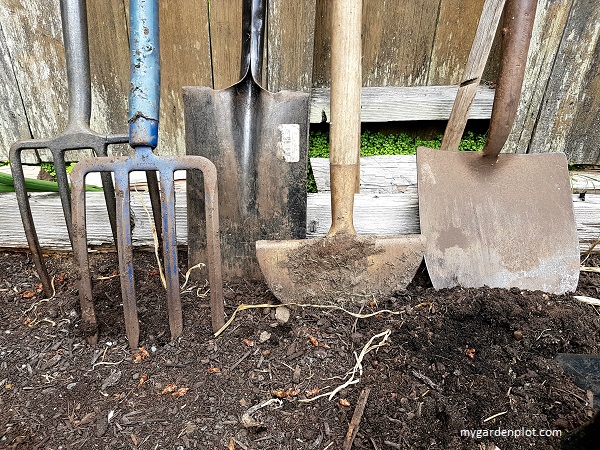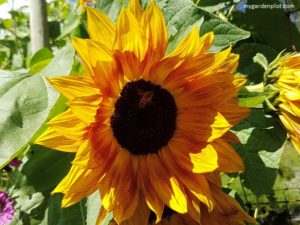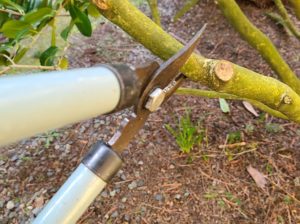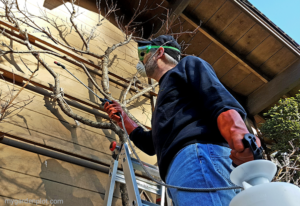Glossary On Must-Have Gardening Tools And Equipment For Beginners
Do you have the right garden tools and equipment for the job? Here is an essential list of gardening tools for both hand-held and power equipment to get you started. What you need will all depend on the size of your garden, whether it is a large area or a manageable patio garden, or if starting a new vegetable garden or planters for container gardening. This guide to garden tools and equipment is divided into six sections to help with your decisions and priorities.
While some are must-have gardening tools, you may not need to have all of these items for your garden – and as we often find, we can usually do with fewer things in our shed. Garden equipment know-how and understanding what you can compromise on and what is essential is the first step in the selection. Secondly, quick access to help you evaluate your needs, budget, and what to do next with your shopping gardening tool list. With some items, such as pruners, I recommend that you purchase the best quality possible within your budget. This will save you time, effort, and additional costs down the road in upgrading to a more dependable brand. Also at the bottom of this page are steps how to care and clean your garden tools.
This guide will cover a list of essential gardening tools for your garden shed broken down for lawns, flower gardening and vegetable beds. Plus those must-have basic tools that are standard for most gardening scenarios:
- Must-Have Standard Garden Tools
- Pruning Toolkit
- Vegetable Gardens Tools
- Tools for Lawn Care
- Rent or Buy Power Tools and Equipment
- Looking after Gardening Tools
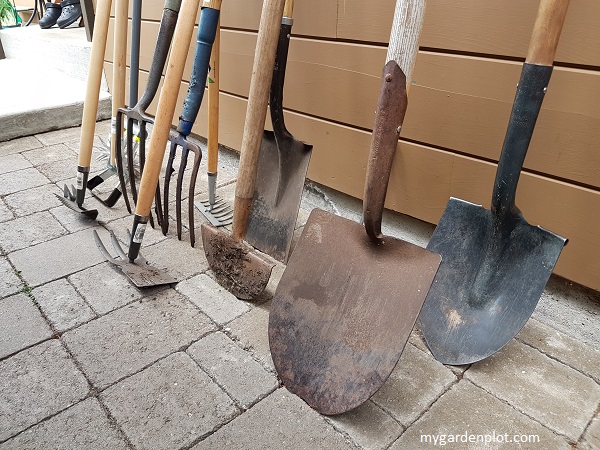
Must-Have Standard Gardening Tools
FORKS: This is an essential garden tool for working your soil and preparing the ground before planting or sowing. Forks with longer prongs are very useful for shifting compost. While the long-handled fork helps with larger areas, a hand fork is indispensable for working in small spaces and help with weeding and cultivating around plants. Shop for Digging Forks
GARDENING GLOVES: It might be debatable if gloves are essential or not. For me, a well-fitting general gardening glove is indispensable with yard work. Saves your hands from calluses and becoming super dirty. And if you have a thorny plant, such as roses or a flowering quince shrub, investing in thorn-proof gloves makes pruning tasks much easier and way less painful (more about a pruner’s toolkit below). Shop for Gardening Gloves
HOE AND WEEDERS: A hoe helps to tackle weeds in the garden beds – there are long- and short-handled hoes and a few blade variations. I like the stirrup hoe, which works on a pulling method that cuts the weeds and doesn’t dig up too much soil in the process. The Dutch hoe results are similar to the stirrup hoe, but it is pushed rather than pulled. The draw hoe has a flat blade that doubles in duty with spreading soil or mulch and removes weed seedlings. The short-handled hoe is called an onion hoe. When it comes to short-handled hoes for tough weeds, the Japanese or Korean digger hoe is a weeding must-have. And if you have dandelions, get a dandelion weeder to help remove those deep-rooted invasive weeds in lawns and garden beds. Shop for Gardening Hoes and Manual Weeders
GARDEN HOSE AND SPRINKLER / NOZZLE: If you do not have an automatic sprinkler system set up and have a large garden or lawn, you will need to rely on a hose along with a sprinkler and hose nozzle. Shop for Garden Hoses and Nozzles
RAKE: Used in the final stages of soil preparation and essential if you have deciduous trees on your property. Come autumn, you will likely be looking for a lightweight rake to gather up all those fallen leaves. Shop for Garden Rakes
SPADE AND SHOVEL: Spades and shovels are used for digging, and soil and planting preparation. There are various blade sizes as well as handle lengths to cater to most gardeners’ comfort range. The blade shape can be curved or square-bottom, which is useful for digging. If you are working in a garden bed you will need a long-handled shovel. A short-handled spade or trowel helps with planting small plants and container gardening. Shop for Garden Spades and Shovels
SPRAYER: Having a pump sprayer is necessary for vegetable or plant maintenance when applying insecticides or fungicides. For these types of jobs, such as using dormant spray on fruit trees, having a compression sprayer is a must-have in your garden shed. If you have a small garden with just a few plants, you will likely not need a sprayer. So you could leave this item off the list. Shop for Garden Sprayers
TROWEL: A trowel is the same as a short-handled spade. Likely the first item purchased for your gardening toolkit. No doubt, you will need this for digging small areas and for planting new specimens. This will get lots of use, buy stainless steel if possible. Shop for Garden Trowels
WATERING CAN: I have a sturdy watering can with a removable spout attachment. Whether the rosehead or showerhead is removable or adjustable, it is an excellent option because it allows you to either water lightly or provides a heavy stream when needed. Remember not to get one that is too large for you to lift when full of water. Select the size that is most manageable for you. Shop for Watering Cans
WHEELBARROW AND GARDEN WAGONS: As much as the old traditional metal wheelbarrows have that nostalgic look that we all love, there are excellent lightweight and ergonomic wheelbarrows available today that lighten the task without breaking the back. Unless your garden is entirely level and flat, check the wheelbarrow’s maneuverability for uneven ground and the how ergonomic the handles are for ease of control. If your garden is fairly level, a garden cart or wagon with four wheels, makes for easy hauling. This will go a long way to lighten the load when moving around soil or compost. Shop for Wheelbarrows and Garden Wagons
RELATED TOPIC: How To Remove And Prevent Weeds
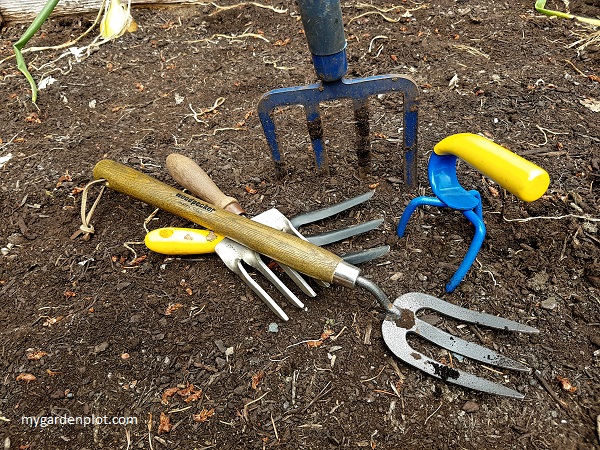
RELATED TOPIC: Buyer’s Guide On How To Choose Hand Pruners (Secateurs)
Pruning ToolKit
You will want to consider the following items for any pruning job, especially if you have shrubs and small to medium-size trees that need annual maintenance. These tools are always an investment. Your purchase should be as good as you can afford.
HAND PRUNERS (SECATEURS) AND LOPPERS: In most gardens, there will be something that needs to be pruned. Pruners and loppers are items that are worth spending a little more on. Pruners are also called secateurs (which is more commonly used in British English). Most of the pruning you do will be with hand pruners. The long-arm pruners, or loppers are for hard-to-reach stems and branches with large shrubs and small trees. Loppers are like pruners but with longer handles. Plus they are considered heavy duty and help to tackle thicker stems and branches. Shop for Garden Pruners and Loppers
HEDGE SHEARS: If you have any hedges or shrubs that need to be trimmed, good quality hedging shears is worth the investment. This is when you remove volumes of about an inch or two of thin ends or young stems. If you tackle a lot of hedging, you may want to consider a power hedge trimmer. Otherwise a good pair of hedge shears should be all that is needed. Shop for Hedge Shears
PRUNING SAWS: There are various types of pruning saws that help with larger branches and stems. One of the most convenient saws to have in your pruner tool kit is the folding saw. It has been indispensable in our pruning toolkit. Shop for Garden Saws
RELATED TOPIC: Buyer’s Guide On How To Choose A Pruning Saw
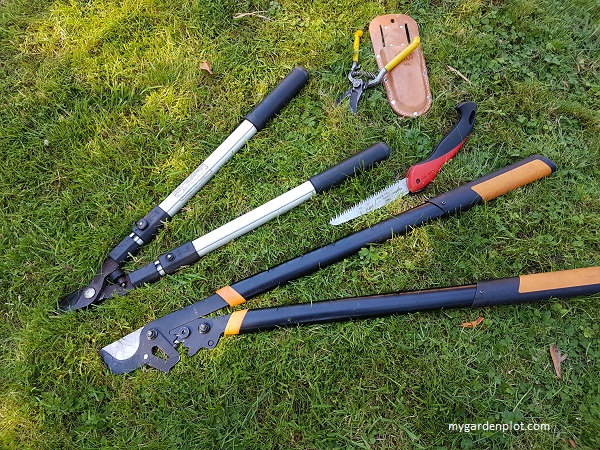
RELATED TOPIC: Buyer’s Guide On How To Choose Loppers
Vegetable Garden Tools
Depending on what vegetables, fruit, or herbs you are growing, you may need to consider crop protection or support systems. Crop protection shields plants from fluctuating cold weather, overnight frosts, strong winds, shading or a barrier from pests and diseases. Support systems are needed for tomatoes and other vegetables and fruit.
CLOCHES: What are cloches? The classic cloche is a small dome-like cover made of plastic or glass. They are placed over young plants or seedlings to protect them from dipping temperatures or overnight frost. They are also used to help raise temperatures in a small, controlled space to help germinate seeds outside – much like in a greenhouse. Purposed-made cloches are useable can be purchased at some garden centres or online shopping. However, some of these can be made from used large plastic bottles by cutting out the bottle’s wider end, something I readily use with my zucchini seedlings planted in spring. There are of course limitations with home-made versions. Cloches can also be made from bamboo. These are better used to provide protection from wind and birds. Some form of a cloche is a must-have for anyone growing vegetables or herbs in their garden. Shop for Garden Cloches
COLD FRAMES: In colder regions, a cold frame will help your seedlings and young plants safe from cooler overnight temperatures. Similar to how a greenhouse would be used. A cold frame is generally an unheated structure that seats low with a sloping roof. The sides may be made of wood, glass or plastic, and the roof is clear to allow any light and opens fully for access and ventilation during the day. You can make these yourself, or purchase purpose-made cold frames designed for year-round use in small spaces. Shop for Plant and Crop Cold Frames
PLANT AND ROW CROP COVERS: These are used to protect plants from extreme weather or pests. And often can help extend the growing season. These can be purchased as a kit, or the components separately. There are different covers, light or heavy-duty, and lengths available – most starting at 6 metres (20 feet). Using pipes, wire or wood as support, the row cover is spread over the crop and on all sides falls to the ground level providing a barrier. Selections include reusable seasonal options for anything from freezing to pest protection. Shop for Plant and Crop Protection Covers
SUPPORT STAKES AND TIES: Some plants and vegetables need support to grow. Anything narrow and long will do. The stakes can be bamboo, wood, or plastic-coated metal stakes. Using reusable wire or twine to tie the plant to the stake helps the plant grow taller with more support. Shop for Plant Support Stakes and Ties
TOMATO SUPPORT CAGES: These are cheap, reusable and dependable for supporting tomato plants as they grow. They can be used for other vegetables too that need extra support. Shop for Tomato Support Cages
Tools For Lawn Care
AERATOR: Needed for compact soil, encourage grass root growth, and prepare the lawn for fertilizing and overseeding. Our preference for small lawns is the manual spike aerator – good on the budget and good for exercise. The most common manual spike aerator is easy to use and has a foot bar for extra support. For large lawns it would be better to use electric aerator. Though I think the aerators strapped to shoes looks like a great option too. Shop for Lawn Aerators
EDGER: It may not be a must-have, but it sure does help do the job nicely compared to using a flat bottomed spade. An edger will keep the grass verge looking neat and tidy. There are electric edgers but for regular sized lawns in most homes, a manual edger is really all that is needed. Shop for a Border Edger
GRASS AND SEED SPREADER: A hand-held spreader for a small lawn makes the task for even distribution of lawn fertilizer and seeds easy. For large lawns, there is a push spreader on wheels that can cope with home lawns. Unless you have a super large property to cover, there is little need for a motorized spreader. Shop for Grass Seed and Fertilizer Spreader
LAWN MOWER: It may seem during spring and summer that everyone is cutting the grass with an electric or gas mower. And if you have a lawn, it is an expectation. Most often you will see the power lawn mower. But there is a growing trend to return to the manual push mower, which is great for exercise and the environment, and for noise pollution. Shop for Lawn Mowers
RELATED TOPIC: Lawn Care Guide
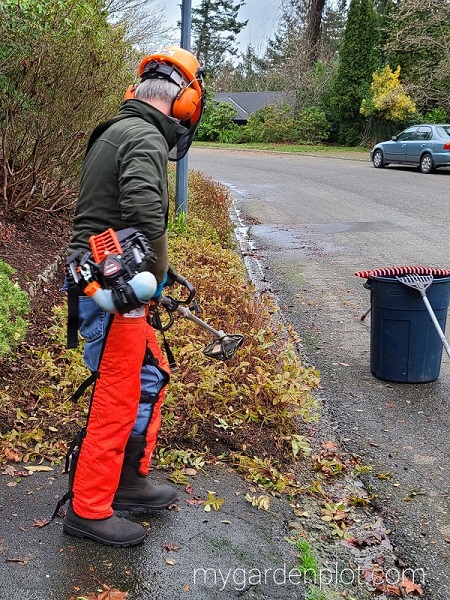
Garden Power Tools: Buy Or Rent?
Before purchasing that expensive power tool for a one-off job, check with your DIY store for rental equipment – unless you can borrow from your neighbour? Some DIY stores offer rental options that can be more cost-efficient than buying for the occasional use – that we all know is likely to gather more dust in the garden shed than actual use.
However, if you need to use a power tool frequently in your garden, as in more than twice a year, buying may be more convenient and necessary for you. Shop for Garden Power Tools And Equipment
Maintaining Your Gardening Tools And Equipment
It is always a good habit to clean your garden tools after using them before storing them at the end of the day. Pruners, loppers and saws should always be disinfected after pruning a plant or tree. By cleaning the blade, it helps stop the spread of any potential diseases. Simply wipe the blade with some alcohol with a paper towel or clean rag.
Your pruners and loppers will also benefit from sharpening using a specialty file at the end of the year. Or if you have a big job, you may find it helpful to do it a few times during the season. Always clean first before sharpening and lubricating tools. Have handy WD-40 spray for removing rust. Complete the process by applying a general-purpose oil to lubricate your pruners’ moving parts and remove any excess. Always keep your tools out of the rain and stored in a clean and dry location. Depending on your saw brand, you may need to get a new blade after a few years or have it professionally sharpened. Shop for Garden Tool Sharpers

